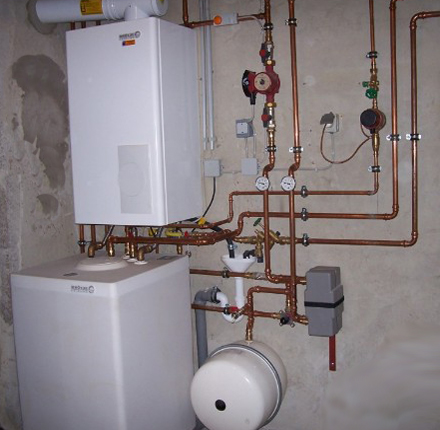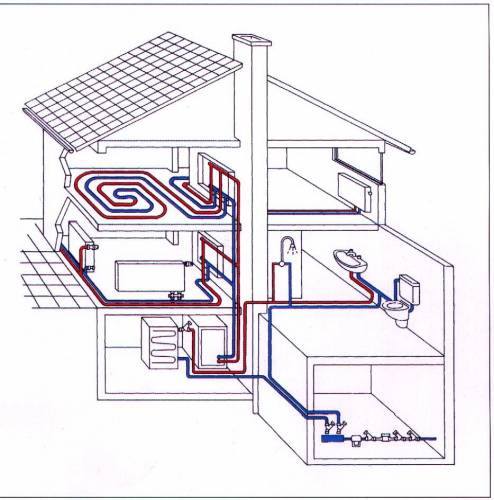central heating
Central heating or central heating is a heating system in which the heat for heating several rooms or several houses is produced in one place and supplied to individual rooms with a heat carrier (water, steam, air).
Hot water heating with a water temperature of up to 100°C is the most widespread. Central heat production is cheaper, the efficiency of large boilers is higher than that of small local devices, and the ecological burden on the environment is reduced.
Central heating and its types
Types of central heating according to heat transfer substances
In central heating systems, water, steam and air are most often used as heating components. That is why we talk about hot water, hot air and steam systems. Each of them has its advantages and disadvantages.
Steam central heating system
At first glance, the costs of this type of central heating are significantly lower than others. 1 kg of condensation steam releases approximately 535 kcal of thermal energy, which is 15 to 20 times more than the amount of heat released from 1 kg of water. Also for this reason, steam pipes have a much smaller diameter than water pipes.
However, the price comparison of costs is relative. First of all, we have to realize that in order to get steam from water, the heating equipment of the central heating must be heated almost permanently to a temperature of 100°C or even higher. In the case of steam boilers, the transport of the heating medium is ensured by its own pressure. For this reason, it is not necessary to install the pump in the supply pipe. On the condensate side, the steam plant does not need an expansion tank. A pressure drop is used to transport steam. Due to the high energy content, pipes with a small cross-section are used. However, the disadvantages mainly include large heat losses caused by condensate, the risk of corrosion, high surface temperatures of the heating elements and, last but not least, the system failure rate.
Are you looking for a company that would build you a reliable central heating system? Click on the pages of the catalog of companies for heating bodies and distribution systems - production, sale, construction and assembly and choose one of the companies in your area.
To compare prices, you can also use the Submit a request system, where you can request a price offer for heating and construction work.
Hot water central heating system
It is the most widespread type of central heating with a water temperature of up to 100°C (actually 50-80°C). It often also serves as a source of hot water supply. Modern heating systems ensure thermal comfort during economical operation, are characterized by hydraulic balance, small water volume and large-area heating elements. By regulating heating systems, it is possible to reduce operating costs to a minimum.
Regulators - (e.g. room thermostats) - ensure the optimal temperature of the heated space. The basic source of heat is a stationary boiler, located in the basement of the building, in the case of heating several buildings or parts of the city, it is located in the central boiler room. In this case, we are also talking about a hot water heating system. Water is heated in the boiler and transported to the heating elements through pipelines. The circulation of the heat carrier is either natural or ensured by a circulation pump.
Hot air central heating system
It is the oldest central heating system. Its essence was already known in ancient Rome and consisted in the fact that heated rooms had a double floor and, depending on their nature and need, also double walls, between which hot air and flue gases of the heating room flowed. This system of vents and canals was called hypocaustum. The second part consisted of equipment for heating and air distribution to individual rooms. This device - sometimes extended to heat water for spa purposes - was called hypocausis.
Warm-air central heating, where hot air was distributed directly into rooms, was used until the early 20th century, especially in public buildings, usually supplemented by fans to speed up circulation. Due to the small heat capacity of the air, however, large heat losses occurred. Disadvantages were also the need for spacious, usually brick shafts, and the fact that the flowing air still swirled the dust. However, in recent years this central heating system has made a successful comeback. It is mainly used in houses with recuperative ventilation and where there is little need for heat. While e.g. in the USA there are huge distributions of warm air central heating, in our parts you will hardly encounter it.
Hot air central heating system
This is the oldest central heating system. It was already known in ancient Rome and consisted of a double floor and, depending on the nature and need, of double walls, between which flowed hot air and flue gases from the heated room. This system of vents and channels was called hypocaustum. The second part consisted of equipment for heating and air distribution to individual rooms. This device - sometimes extended by heating water for bathing purposes - was called hypocausal.
Warm-air central heating, where hot air is distributed directly into rooms, was used until the beginning of the 20th century, especially in public buildings, usually supplemented with fans to speed up circulation. Due to the small heat capacity of the air, however, there were large heat losses. The disadvantage was also the necessity of spacious, usually brick shafts and the fact that the flowing air constantly stirred up the dust. In recent years, however, this central heating system has made a successful comeback. It is mainly used in houses with recuperative ventilation and where there is little need for heat. While, for example, there are huge hot air central heating systems in the USA, you hardly ever come across them here.


